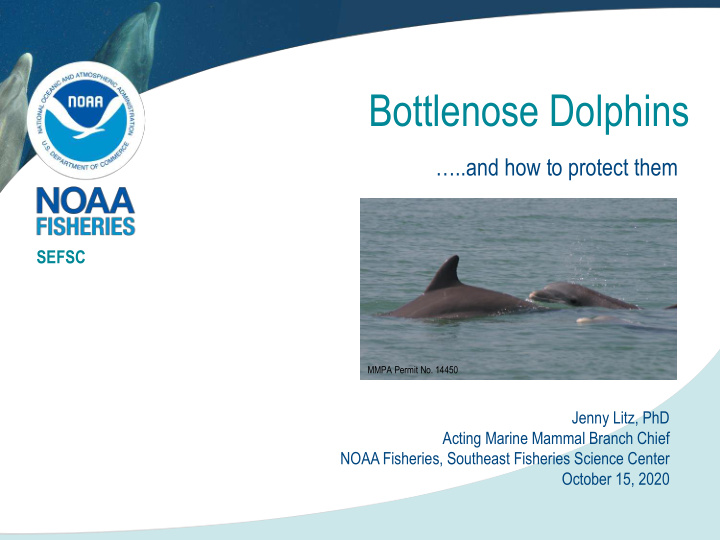



Bottlenose Dolphins …..and how to protect them SEFSC MMPA Permit No. 14450 Jenny Litz, PhD Acting Marine Mammal Branch Chief NOAA Fisheries, Southeast Fisheries Science Center October 15, 2020
NOAA, SEFSC, Marine Mammal Program • Promote stewardship of MM populations through science-based conservation and management • Research seeks to: • Monitor abundance of dolphin and whale populations • Delineate population and stock structure (>25 species and >90 stocks) • Assess human impacts and determine the status of marine mammal populations • Examine causes of mortalities and perform risk assessments • Investigate mitigation measures to protect marine mammals while minimizing effects on economic activities GoM Bryde’s whale: SEFSC MMPA Permit Sperm whale: SEFSC MMPA Permit Pilot whale North Atlantic Right Whale U.S. Department of Commerce | National Oceanic and Atmospheric Administration | NOAA Fisheries | Page 2
NOAA, SEFSC, Marine Mammal Program Our toolkit includes: • Research cruises for oceanic species Aerial surveys for coastal species • • Small boat surveys in Bay/sounds/estuaries • Passive acoustics Genetics • • Tagging and biopsy Stranding response •
Biscayne Bay Bottlenose Dolphin Study • Comprehensive Photo-ID sampling since 1994 • Over 400 dolphins in the catalog • ~300 seen in recent years (2010-2019) • Previous analyses included social structure, genetics for population structure, and POPs
Study Area Northern Biscayne Bay is more extensively developed than southern Biscayne Bay U.S. Department of Commerce | National Oceanic and Atmospheric Administration | NOAA Fisheries | Page 5
How Photo-ID works • Appropriate research permits to photograph dolphins, procedures to limit harassment • Thousands of photographs and data are collected in the field U.S. Department of Commerce | National Oceanic and Atmospheric Administration | NOAA Fisheries | Page 6
How Photo-ID works Chop dorsal fin • Photos are sorted, matched and cataloged Trailing edge notches • Survey, sighting and MMPA Permit No. 14450 animal data is entered Dorsal fin tip into an archival missing, trailing database edge notches MMPA Permit No. 14450 Trailing edge notches Distinctive scratches or scars Leading edge notch MMPA Permit No. 14450 U.S. Department of Commerce | National Oceanic and Atmospheric Administration | NOAA Fisheries | Page 7
Biscayne Bay Sighting Histories Dolphin #008 – first sighted in 1990 Has been sighted 94 times, with at least 9 calves and 4 “grand - calves” identified so far. Primarily seen in the northern half of the Bay. #008 2015 #008 1994 MMPA Permit No. 14450 MMPA Permit No. 14450 #213 (3 rd calf of #008 with her calf, 2018) U.S. Department of Commerce | National Oceanic and Atmospheric Administration | National Marine Fisheries Service | Page 8
Biscayne Bay Sighting Histories Dolphin #072 – first sighted in 1994 Has been sighted 43 times, with at least 5 calves Primarily seen in the southern half of the Bay #072 1995 #072 2019 MMPA Permit No. 14450 #072 with calf 2016 MMPA Permit No. 14450 U.S. Department of Commerce | National Oceanic and Atmospheric Administration | NOAA Fisheries | Page 9
MMPA Permit No. 14450 Persistent Organic Pollutants (POPs) S PCBs in 31 male/juv dolphins • Northern BB dolphins have high levels of PCBs • Studies elsewhere link high PCBs in dolphins to decreased immune function and reduced reproductive success • Dolphins are reflective of the bioavailable contaminants in their ecosystem S PCBs in sediments (Litz et. al. 2007) (NOAA, NS&T Program, 1999) U.S. Department of Commerce | National Oceanic and Atmospheric Administration | National Marine Fisheries Service
Stressors – not just Biscayne Bay but everywhere • Urban development • Habitat loss • Boat traffic/harassment Photo: NOAA • Noise • Contaminants/run-off • Fishing gear Photo: NOAA entanglement/ingestion • Marine debris entanglement/ingestion Photo: HSWRI U.S. Department of Commerce | National Oceanic and Atmospheric Administration | National Marine Fisheries Service
Responsible viewing Chronic disturbance from vessels and swimmers can cause both short- and long-term impacts to dolphins such as: • Injury or death from boat strikes • Separation of mom/calf • Changes in social structure • Abandonment of habitat • And more…. https://www.fisheries.noaa.gov/topic/marine-life-viewing-guidelines#guidelines-&-distances U.S. Department of Commerce | National Oceanic and Atmospheric Administration | National Marine Fisheries Service
There are many harmful effects of feeding dolphins: increase in fishing gear entanglements and ingestions Photo: Mote Marine Lab
Marine Debris – Entanglement and Ingestion Photo credit: Sarasota Dolphin Research Program Photo credit: FMMSN U.S. Department of Commerce | National Oceanic and Atmospheric Administration | NOAA Fisheries | Page 14
15
How you can help dolphins? 1. Don't feed or attempt to feed wild dolphins! 2. Admire From A Distance! Stay far away! 3. Recycling Fishing Line and Trash! 4. Follow Dolphin Friendly Fishing Tips! 5. Properly dispose of trash & don’t release balloons 6. Report stranded or injured dolphins or whales to: 1-877-WHALE HELP (877-942-5343)
So you want to be a marine scientist ? • Volunteer/internships • Work hard – don’t be afraid to do the boring stuff • Study hard – math and science are important but so are reading and writing • Don’t be afraid to follow your dreams but also be willing to adapt to new opportunities
While some days look like this….
Most days look like this….
Thank you !!
Recommend
More recommend